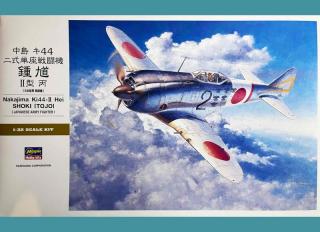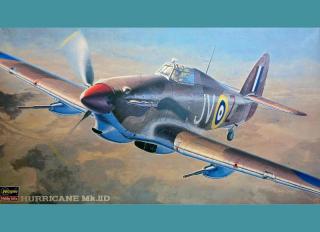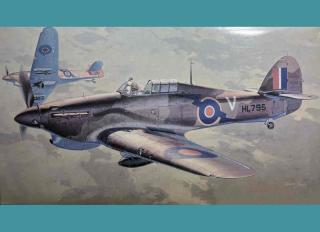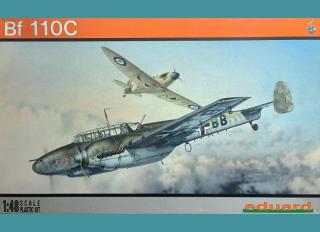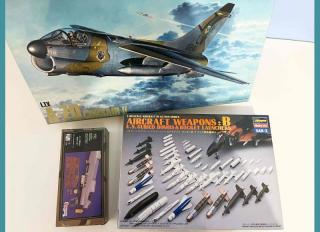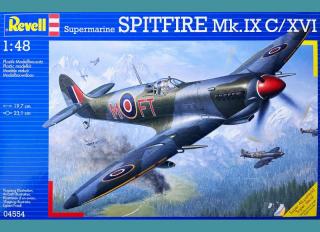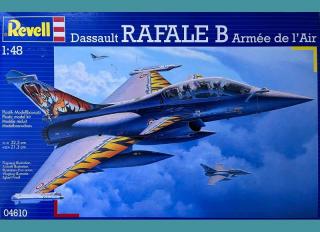Nakajima Ki44-II Hei SHOKI (TOJO)
The Nakajima Type 2 "Shoki" was a single-seater fighter used by the Imperial Japanese Army Air Force (IAAF) during the Second World War. The origins of the design line in the IAAF's high degree of research interest in heavy fighter designs in the late 1930s. In late 1938, the IAAF commissioned the Nakajima Aircraft Company to begin research on a heavy fighter design concept putting an emphasis on speed, with armament consisting of a single cannon and two smaller caliber machine guns. On June 2, 1939, t
- Sklep: Sklep Modelarski, Modelarstwo, Modele do Sklejania - FlyModel / Gomix
- Cena: 250.00 zł
Focke-Wulf Fw190A-4 «GRAF»
The Fw190 was developed to perform a supporting role for the Luftwaffe's mainstay fighter, the Messerschmitt Bf109. The Focke-Wulf was powered by a radial engine - - a rare feature in a European fighter of the era. With a tough construction and superb maneuverability, the efficiency and practicality of the design afforded the Fw190 considerable versatility, and modifications and variants meant the aircraft was able to perform a wide variety of combat roles through to the end of the war. The Fw190A-4 is
- Sklep: Sklep Modelarski, Modelarstwo, Modele do Sklejania - FlyModel / Gomix
- Cena: 190.00 zł
Hurricane Mk I
Sidney Camm, chief designer for the Hawker Engineering Company, had vision to see that the biplane era was nearing its end. In 1925 he designed a monoplane (never built knowing that this was the fighter type of the future . In 1933, under Camm's direction, Hawker began work on a monoplane which was an adaption of their successful Hawker Fury biplane. It initially used a 660 hp Rolls Royce engine, but was changed to the higher potential 1 Rolls Royce PV12, that became the famous Merlin engine. In la
- Sklep: Sklep Modelarski, Modelarstwo, Modele do Sklejania - FlyModel / Gomix
- Cena: 175.00 zł
Hurricane Mk II C
The MkIIC Hurricane came about when the British Air Ministry requested a single seat day and night fighter armed with four 20mm cannon. Hawker proposed fitting cannons to their Hurricane: however the government did not feel that the airframe could take the abuse of the 4 cannons, so they gave the contract to the Westland corporation for their twin engined Whirlwind. There were very few 20mm cannons around in those days and England had approached Hispano Suiza for a license to build their cannons in Englan
- Sklep: Sklep Modelarski, Modelarstwo, Modele do Sklejania - FlyModel / Gomix
- Cena: 175.00 zł
Hurricane Mk II D
Following the Battle of Britain, the Hurricane's days as a front-line fighter came to a close, but it continued to serve proudly as a night-fighter, reconnaissance platform and ground-attack plane in a number of different variations for the rest of the war. It was in this latter role, that a number of unique and effective modifications were seen. Perhaps the most impressive of these was the mounting of 40mm machine cannons to turn the plane into a «tank-buster,» similar to the GermanJu87G. This was
- Sklep: Sklep Modelarski, Modelarstwo, Modele do Sklejania - FlyModel / Gomix
- Cena: 175.00 zł
Hurricane Mk II B
Sidney Camm, chief designer for the Hawker Engineering Company, had vision to see that the biplane era was nearing its end. In 1925 he designed a monoplane (never built ) knowing that this was the fighter type of the future.In 1933, under Camm's direction, Hawker began work on a monoplane which was an adaption of their successful Hawker Fury biplane. It initially used a 660 hp Rolls Royce engine, but was changed to the higher potential I Rolls Royce PV12, that became the famous Merlin engine. In late
- Sklep: Sklep Modelarski, Modelarstwo, Modele do Sklejania - FlyModel / Gomix
- Cena: 175.00 zł
Mirage III
The first example of the Mirage II C flew on 9 October 1960 .It was the first production series to be built. The Mirage III C was a single-seat interceptor powered by Atar 09B-3 turbojet Armed with two 125-round DEFA 30-mm cannon, and it was also equipped with five wing pylons .As a interceptor, the aircraft had a whole series of air-to-air missile (Matra R-511 or R-530, Sidewinders) when they used in the ground attack role, which were replaced by air-to ground missiles (AS.20 ,AS.30) or JL100R rocket lau
- Sklep: Sklep Modelarski, Modelarstwo, Modele do Sklejania - FlyModel / Gomix
- Cena: 130.00 zł
Bf 110 C
Historie slavného Zerstöreru Bf 110 se zadala psát na konci roku 1934, kdy C-Amt RLM (Technicky úrad Risského ministerstva letectvi) vydal specifikace pro dvoumistné dvoumotorové letouny kategorie Kamfzerstörer. Do konkurzu vstoupily firmy Focke- Wulf (Fw 57), Henschel (Hs 124) a BFW (Messerschmitt Bf 110). Na jare 1935 RLM své názory prehodnotilo, univerzálni kategorii Kamfzerstörer zrusilo ve prospèch dvou specializovanych kategorii Schnellbomber a Zerstörer. Pozadavküm RLM na tezky stihaci stroj Ze
- Sklep: Sklep Modelarski, Modelarstwo, Modele do Sklejania - FlyModel / Gomix
- Cena: 220.00 zł
Bf 110 E
Historie slavného Zerstöreru Bf 110 se zacala psát na konci roku 1934, kdy C-Amt RLM (Technicky úrad Risského ministerstva letectvi) vydal specifikace pro dvoumistné dvoumotorové letouny kategorie Kamfzerstörer. Do konkurzu vstoupily firmy Focke-Wulf (Fw 57), Henshel (Hs 124) a BFW (Messerschmitt Bf 110). Na jare 1935 RLM své názory prehodnotilo, univerzálni kategorii Kamfzerstörer zrusilo ve prospech dvou specializovanych kategorii Schnellbomber a Zerstörer. Pozadavkum RLM na tezky stihaci stroj Zers
- Sklep: Sklep Modelarski, Modelarstwo, Modele do Sklejania - FlyModel / Gomix
- Cena: 220.00 zł
Hawker Sea Fury FB.11
The first Sea Fury prototype, powered by a Bristol Centaurus XII, had first flown on 21 February 1945, but the first fully-navalized version with folding wings did not fly until 12 October 1947. The Bolton Paul contract was cancelled in early 1945, and of the 100 Sea Furies that remained on order, the first 50 were completed under the designation Sea Fury Mk X. In May 1948, the first Sea Furies became operational with No. 802 Squadron, in the form of the Sea Fury FB.Mk 11, of which 615 were built. At leas
- Sklep: Sklep Modelarski, Modelarstwo, Modele do Sklejania - FlyModel / Gomix
- Cena: 190.00 zł
A-7D Corsair II (Zestaw 3 w 1)
The Ling Tomco Vought (L.T.V.) A-7D Corsair II is an offensive aircraft of the U. S. Air Force. The U. S. Air Force acquired the U. S. Navy's A-7A for its excellent ability and low cost as a successor to the F-100 Super Sabre to become its main aircraft. The D model is based on a vastly improved A model. The P TF-30 engines have been replaced by the Allison TF-41 A-1 Turbo engines. Moreover, the aircraft was fitted with an A. P. U. (Auxiliary Power Unit) to reinforce it. The fixed armament consists o
- Sklep: Sklep Modelarski, Modelarstwo, Modele do Sklejania - FlyModel / Gomix
- Cena: 675.00 zł
DONGLAS A-1H SKYRAIDER U. S. NAVY
During 1943 the U. S. Bureau of Aeronautics considered to combine the tasks of torpedo bomber and dive-bomber into one. Several aircraft manufacturers, such as Douglas and Martin, were requested to develop a large, single-seat attack aircraft. According to the requirement, Douglas Skyraider, was developed by Douglas Aircraft Company, Inc. The develop ment was started in early July 1944, and all night efforts of engineers made the first prototype's first flight possible already on March 18, 1945. Despite o
- Sklep: Sklep Modelarski, Modelarstwo, Modele do Sklejania - FlyModel / Gomix
- Cena: 175.00 zł
F4U-7 Corsair
In February 1938, when the US Navy invited tenders for a new fighter-interceptor for service on aircraft carriers, the specifications seemed like a request to square the circle. They asked for a top speed of over 560 km/h at an altitude of over 6,000 m, combined with a robust airframe for landing on aircraft carriers and outstanding low-speed flight characteristics. Chance Vought Aircraft Division finally received the order to build a prototype of one of two concepts submitted, under the designation XF4U-
- Sklep: Sklep Modelarski, Modelarstwo, Modele do Sklejania - FlyModel / Gomix
- Cena: 140.00 zł
Supermarine SPITFIRE Mk.IX C/XVI
The prototype Supermarine Spitfire flew on 26 March 1936, and the first Spitfires for the RAF were delivered in May 1938; by August 1940 there were 19 squadrons of Mk.ls and Ils. These early Spitfires were barely superior to the German Messerschmitt Bf109E and in order to maintain superiority the more powerful Mk.V. with a Merlin 45 engine was produced. The Mks. Vb and Vc were cannon-armed versions, the Vc equipped with what was known as the 'Universal' wing; Mk.Vs went into mass production, entering serv
- Sklep: Sklep Modelarski, Modelarstwo, Modele do Sklejania - FlyModel / Gomix
- Cena: 180.00 zł
Dassault Rafale B
Rafale B is the two-seat version of the Rafale C, an Air-Superiority Fighter of the French Air Force and likewise the single-seat Rafale M which since 2002 has been deployed with the French Navy on the aircraft carrier "Charles de Gaulle" in the fighter role. The Rafale B was built to replace the two-seat Mirage 2000-5F which over the last few years has seen action in almost all theatre's of war with the Armée de l'Air as a multi-role fighter aircraft. The RAFALE B presents itself as a very modern fig
- Sklep: Sklep Modelarski, Modelarstwo, Modele do Sklejania - FlyModel / Gomix
- Cena: 140.00 zł
